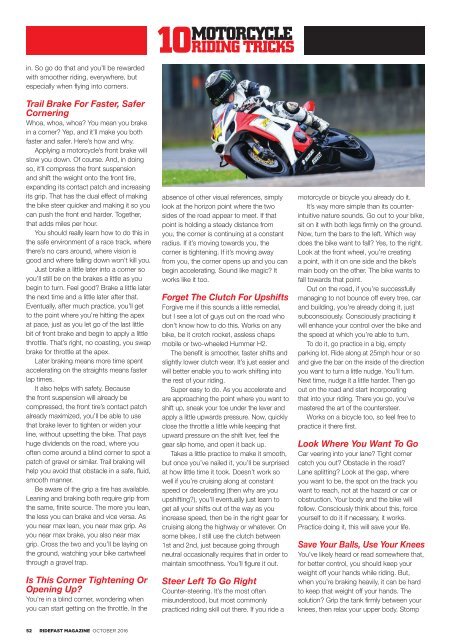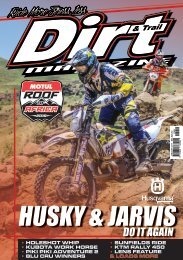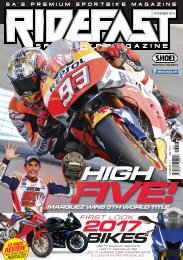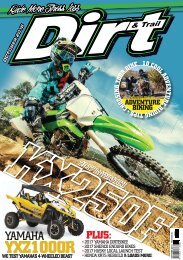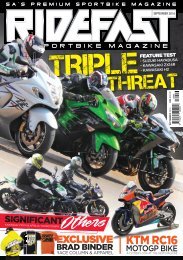1610 RF final
RideFast Magazine October 2016 Issue
RideFast Magazine October 2016 Issue
You also want an ePaper? Increase the reach of your titles
YUMPU automatically turns print PDFs into web optimized ePapers that Google loves.
in. So go do that and you’ll be rewarded<br />
with smoother riding, everywhere, but<br />
especially when flying into corners.<br />
Trail Brake For Faster, Safer<br />
Cornering<br />
Whoa, whoa, whoa? You mean you brake<br />
in a corner? Yep, and it’ll make you both<br />
faster and safer. Here’s how and why.<br />
Applying a motorcycle’s front brake will<br />
slow you down. Of course. And, in doing<br />
so, it’ll compress the front suspension<br />
and shift the weight onto the front tire,<br />
expanding its contact patch and increasing<br />
its grip. That has the dual effect of making<br />
the bike steer quicker and making it so you<br />
can push the front end harder. Together,<br />
that adds miles per hour.<br />
You should really learn how to do this in<br />
the safe environment of a race track, where<br />
there’s no cars around, where vision is<br />
good and where falling down won’t kill you.<br />
Just brake a little later into a corner so<br />
you’ll still be on the brakes a little as you<br />
begin to turn. Feel good? Brake a little later<br />
the next time and a little later after that.<br />
Eventually, after much practice, you’ll get<br />
to the point where you’re hitting the apex<br />
at pace, just as you let go of the last little<br />
bit of front brake and begin to apply a little<br />
throttle. That’s right, no coasting, you swap<br />
brake for throttle at the apex.<br />
Later braking means more time spent<br />
accelerating on the straights means faster<br />
lap times.<br />
It also helps with safety. Because<br />
the front suspension will already be<br />
compressed, the front tire’s contact patch<br />
already maximized, you’ll be able to use<br />
that brake lever to tighten or widen your<br />
line, without upsetting the bike. That pays<br />
huge dividends on the road, where you<br />
often come around a blind corner to spot a<br />
patch of gravel or similar. Trail braking will<br />
help you avoid that obstacle in a safe, fluid,<br />
smooth manner.<br />
Be aware of the grip a tire has available.<br />
Leaning and braking both require grip from<br />
the same, finite source. The more you lean,<br />
the less you can brake and vice versa. As<br />
you near max lean, you near max grip. As<br />
you near max brake, you also near max<br />
grip. Cross the two and you’ll be laying on<br />
the ground, watching your bike cartwheel<br />
through a gravel trap.<br />
Is This Corner Tightening Or<br />
Opening Up?<br />
You’re in a blind corner, wondering when<br />
you can start getting on the throttle. In the<br />
10 MOTORCYCLE<br />
RIDING TRICKS<br />
absence of other visual references, simply<br />
look at the horizon point where the two<br />
sides of the road appear to meet. If that<br />
point is holding a steady distance from<br />
you, the corner is continuing at a constant<br />
radius. If it’s moving towards you, the<br />
corner is tightening. If it’s moving away<br />
from you, the corner opens up and you can<br />
begin accelerating. Sound like magic? It<br />
works like it too.<br />
Forget The Clutch For Upshifts<br />
Forgive me if this sounds a little remedial,<br />
but I see a lot of guys out on the road who<br />
don’t know how to do this. Works on any<br />
bike, be it crotch rocket, assless chaps<br />
mobile or two-wheeled Hummer H2.<br />
The benefit is smoother, faster shifts and<br />
slightly lower clutch wear. It’s just easier and<br />
will better enable you to work shifting into<br />
the rest of your riding.<br />
Super easy to do. As you accelerate and<br />
are approaching the point where you want to<br />
shift up, sneak your toe under the lever and<br />
apply a little upwards pressure. Now, quickly<br />
close the throttle a little while keeping that<br />
upward pressure on the shift liver, feel the<br />
gear slip home, and open it back up.<br />
Takes a little practice to make it smooth,<br />
but once you’ve nailed it, you’ll be surprised<br />
at how little time it took. Doesn’t work so<br />
well if you’re cruising along at constant<br />
speed or decelerating (then why are you<br />
upshifting?), you’ll eventually just learn to<br />
get all your shifts out of the way as you<br />
increase speed, then be in the right gear for<br />
cruising along the highway or whatever. On<br />
some bikes, I still use the clutch between<br />
1st and 2nd, just because going through<br />
neutral occasionally requires that in order to<br />
maintain smoothness. You’ll figure it out.<br />
Steer Left To Go Right<br />
Counter-steering. It’s the most often<br />
misunderstood, but most commonly<br />
practiced riding skill out there. If you ride a<br />
motorcycle or bicycle you already do it.<br />
It’s way more simple than its counterintuitive<br />
nature sounds. Go out to your bike,<br />
sit on it with both legs firmly on the ground.<br />
Now, turn the bars to the left. Which way<br />
does the bike want to fall? Yes, to the right.<br />
Look at the front wheel, you’re creating<br />
a point, with it on one side and the bike’s<br />
main body on the other. The bike wants to<br />
fall towards that point.<br />
Out on the road, if you’re successfully<br />
managing to not bounce off every tree, car<br />
and building, you’re already doing it, just<br />
subconsciously. Consciously practicing it<br />
will enhance your control over the bike and<br />
the speed at which you’re able to turn.<br />
To do it, go practice in a big, empty<br />
parking lot. Ride along at 25mph hour or so<br />
and give the bar on the inside of the direction<br />
you want to turn a little nudge. You’ll turn.<br />
Next time, nudge it a little harder. Then go<br />
out on the road and start incorporating<br />
that into your riding. There you go, you’ve<br />
mastered the art of the countersteer.<br />
Works on a bicycle too, so feel free to<br />
practice it there first.<br />
Look Where You Want To Go<br />
Car veering into your lane? Tight corner<br />
catch you out? Obstacle in the road?<br />
Lane splitting? Look at the gap, where<br />
you want to be, the spot on the track you<br />
want to reach, not at the hazard or car or<br />
obstruction. Your body and the bike will<br />
follow. Consciously think about this, force<br />
yourself to do it if necessary, it works.<br />
Practice doing it, this will save your life.<br />
Save Your Balls, Use Your Knees<br />
You’ve likely heard or read somewhere that,<br />
for better control, you should keep your<br />
weight off your hands while riding. But,<br />
when you’re braking heavily, it can be hard<br />
to keep that weight off your hands. The<br />
solution? Grip the tank firmly between your<br />
knees, then relax your upper body. Stomp<br />
52 RIDEFAST MAGAZINE OCTOBER 2016


